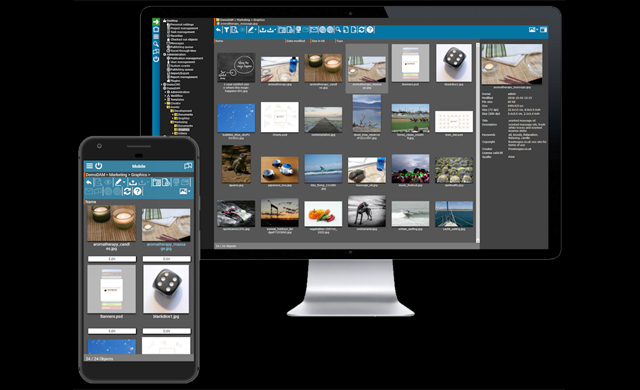These days, creative teams have to deal with an increased number of specialized digital requests, more file formats, and more distribution channels than ever before. Consider how many times you hear the following questions every week:

- Can you help me locate the layered PSD file for my project, or will it need to be recreated?
- Do we have international usage rights on this image?
- How many pieces were created for our holiday campaign last year – and in which sizes?
- Where is the most recent version for the banner for our homepage?
- I cannot locate the original image that was used in our last spring campaign. Will I have to buy it again?
- Can you email, upload, download, reformat, or resize our company’s logo to me?
Digital Asset Management (or DAM for short) can answer all of those annoying questions. It is absolutely necessary for teams that are creating, managing, delivering, and archiving hundreds to thousands of digital assets each year.
Many businesses can’t imagine why they would ever need it. After all, they use Adobe Creative Cloud, OneDrive, Google Drive, Box, and Dropbox already, along with hard drives and internal servers.
That is exactly what the problem is. McKinsey Global Institute reports that nearly 20% of the average worker’s workweek – or 1 day per week – is spent looking for and collecting information from widespread sources and locations. Getting one repository implemented for all digital assets potentially can save may hours of time per week per worker. As a matter of fact, 73% of the best-performing content marketers depend on centralized content and assets.
It is a big project to transfer your complete archive of MOV, PNG, PSD, and other types of files over to a cloud-based system. However, the following tips can help to ensure that you succeed.
1. Get Buy-In From Your Stakeholders
Identify and engage with all of your key stakeholders. This includes any who needs access to, manages, or creates digital files. This is a critical step in the overall process. You are much more likely to get widespread adoption if you have champions who lobby for using your new DAM system.
Be sure to talk about some of the important but lesser-known benefits provided by DAM software, including being able to:
Control your brand through the use of automatic notifications and expirations, approved versions of assets such as logos, and centralized branding guidelines.
Find what you are searching for within seconds using searchable keywords and filters.
Capture metadata (such as the color type and file type) direct from wherever the asset was created.
Set assets so they expire. This will prevent outdated brand materials from being used, rights-managed images will be accessible beyond a certain date, and seasonal content becomes unavailable.
Use various levels of permissions and access to keep your files safe and control access.
Share assets as a collection, via a download link, or a direct link, without needing to use a USB drive, email attachment, or FTP server.
Publish images directly from your DAM to social media sites or web channels.
With just one click, convert files (for example, from PSD to web-friendly high-res PDFs, JPEGs, or PNGs) right inside the DAM.
Don’t settle for any solution that does not provide all of the benefits above.
2. Select the Best Solution
Nearly half (48%) of all creative teams have not implemented any type of digital asset management system. Out of the 52% of those that do have one, many have on-premises, outdated solutions that do not have the necessary flexibility to stay current on the latest tech trends (such as the explosion of social media) along with integrating it with other forms of marketing technology.
Whether it is the first time you are implementing a solution or are upgrading, make sure you become thoroughly familiar with the specific requirements of your team before you choose a vendor. Speak to Intelligence Bank who will guide you through your choices. First of all, understand the kinds of assets (video, audio, images) that need to be managed, then get assistance from your IT team in order to determine what your function needs are (distribution, file conversion, search) as well as your IT requirements (platform, hosting, security).
3. Don’t Forget About Training
Everyone is going to be involved in some way with your DAM solution – from HR and finance to marketing and sales – need to be properly trained on how the solution needs to be used. Offer comprehensive, in-depth training for your system administrators who will be organizing assets, adding and naming new files, capturing metadata, setting expiration dates, and much more. Prior to this training, required metadata fields, folder hierarchy, and naming conventions will need to be defined.
On the other hand, regular system users just need to know how to locate files, create collections for collaboration purposes, distribute files to customers and clients, and access your DAM from your mobile devices.
Also think about assigning one or more group members to act as your Librarian or Digital Asset Manager who will have the responsibility to consistently catalogue and update information within the database. That can help to prevent critical information from being misspelled or omitted – mistakes that can make it hard to find important assets down the road.
4. Integrate Your DAM With Other Solutions
It is essential for your DAM solution to support integration with other types of IT systems, content management systems, eCommerce systems, project management solutions, intranet sites, websites, and design software such as Photoshop and Adobe InDesign. There is also Single Sign-On, that allows employees to gain access to the system by using their current credentials.
Those integrations cannot happen all at the same time, so you need to prioritize which ones are the most important to your business, and gradually take them on. For instance, if third-party marketing platforms are really important, begin with that. Just think about all of the time that will save your team after they are able to directly access DAM assets from the platforms that they use already for social media, emails, blogging, and automation for your business.
5. Hold Everyone Accountable
Adoption is often a problem with software solutions. People get used to doing things the old way, and adapting to a new process will take time.
Fortunately, it is not too hard to set a process up for inserting completed new assets into a DAM. Many systems, in fact, make it possible for you to develop a pre-built workflow that sends approved, completed files automatically into the right folder structure.
For those who are just searching for assets and not trying to upload or create them, some accountability is needed. Stakeholders who are accustomed to emailing a designer to get the latest banner size or logo will need to be reminded that they have direct access to them now.. After they realize that it takes less time to access the DAM than it does to write an emai and then having to wait for a reply from the designed with the attached JPEG they need, they will comply.







